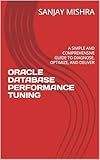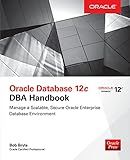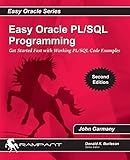Best Oracle Database Tools to Buy in December 2025

ORACLE DATABASE PERFORMANCE TUNING: A SIMPLE AND COMPREHENSIVE GUIDE TO DIAGNOSE, OPTIMIZE, AND DELIVER



OCE Oracle Database SQL Certified Expert Exam Guide (Exam 1Z0-047) (Oracle Press)
- MINT CONDITION GUARANTEE: SHOP WITH CONFIDENCE!
- SAME DAY DISPATCH: ORDER BY NOON FOR SPEEDY DELIVERY!
- HASSLE-FREE RETURNS: NO QUIBBLES, JUST EASY EXCHANGES!



Oracle Database 12c The Complete Reference (Oracle Press)
- AFFORDABLE PRICES FOR QUALITY READS WITHOUT THE NEW BOOK COST.
- ECO-FRIENDLY CHOICE: REUSE AND REDUCE WASTE WITH EVERY PURCHASE.
- UNIQUE FINDS: DISCOVER RARE TITLES AND HARD-TO-FIND GEMS!



Oracle Database 11g DBA Handbook (Oracle Press)



Oracle Database 12c DBA Handbook (Oracle Press)



Expert Oracle Application Express
- HIGH-QUALITY BOOKS AT AFFORDABLE PRICES
- SUSTAINABLY SOURCED: ECO-FRIENDLY READING OPTIONS
- THOROUGHLY INSPECTED FOR QUALITY AND LONGEVITY



Easy Oracle PLSQL Programming: Get Started Fast with Working PL/SQL Code Examples (Easy Oracle Series)


You can update multiple rows in Oracle by using a single SQL update statement with the help of a WHERE clause. Here's how you can do it:
- Start by connecting to your Oracle database using a tool like SQL Developer or SQL*Plus.
- Write a SQL update statement that includes the table name and the column(s) you want to update. For example:
UPDATE table_name SET column1 = value1, column2 = value2
- Add a WHERE clause to specify the condition for updating multiple rows. This condition should match the rows you want to update. For instance:
WHERE condition
- Replace table_name with the actual name of the table you want to update.
- Modify column1 = value1, column2 = value2 to set the new values for the columns you want to update. Replace column1, value1, column2, and value2 with the appropriate column names and values.
- Specify the desired condition after the WHERE clause. It can be as simple as 1=1 to update all rows in the table, or you can use specific criteria. For example, WHERE column3 = 'value3' to update rows where column3 is equal to 'value3'.
- Execute the SQL statement to update the rows.
Make sure to be cautious while updating multiple rows as it can affect a significant amount of data. It's recommended to test your SQL update statement with a SELECT statement first to verify that it targets the correct rows.
What is the impact on performance when updating multiple rows in Oracle?
Updating multiple rows in Oracle can have a significant impact on performance. The exact impact depends on various factors such as the size of the updates, the complexity of the SQL statement, the number of indexes on the updated tables, and the server's hardware and workload.
Here are some potential performance impacts when updating multiple rows in Oracle:
- Increased I/O: Updating multiple rows may require reading and updating multiple data blocks, leading to increased I/O operations. This can cause additional disk access and potentially slow down the overall performance.
- Lock contention: While updating rows, Oracle will acquire locks to ensure data consistency. If multiple sessions are updating the same data simultaneously, it can lead to lock contention and delays. This can impact the performance as other sessions may need to wait for the locks to be released.
- Undo and redo overhead: Oracle maintains the old and new versions of the data during an update. This requires additional space in the undo and redo logs. If the update affects a large number of rows or involves significant changes in the data, it can generate substantial undo and redo overhead, potentially impacting performance.
- Index maintenance: If the updated columns are part of one or more indexes, Oracle needs to update the indexes as well. Updating indexes can be an expensive operation, especially if the index is large or contains many affected rows. It can lead to increased CPU and I/O overhead.
To mitigate the impact on performance while updating multiple rows in Oracle, you can consider various strategies such as batch processing, minimizing lock contention, optimizing SQL statements, using parallel processing where appropriate, and ensuring proper indexing and database tuning. Performance can also be improved by designing efficient data models and using appropriate database features like partitioning.
How to update multiple rows in Oracle with a single value?
To update multiple rows in Oracle with a single value, you can use the UPDATE statement along with the SET clause and a condition to specify which rows need to be updated. Here's an example:
UPDATE table_name SET column_name = new_value WHERE condition;
Replace table_name with the name of your table, column_name with the name of the column you want to update, new_value with the single value you want to update all rows to, and condition with a condition that identifies the rows you want to update.
For example, if you have a table called "customers" and you want to update the "status" column to "active" for all customers whose "age" is above 30, you can use the following query:
UPDATE customers SET status = 'active' WHERE age > 30;
This will update the "status" column to "active" for all rows that meet the specified condition.
What is the default transaction behavior when updating multiple rows in Oracle?
The default transaction behavior when updating multiple rows in Oracle is that each row is updated individually within its own transaction.
How to update multiple rows in Oracle using the bulk collect feature?
To update multiple rows in Oracle using the bulk collect feature, you can follow these steps:
- Declare a collection type that matches the data type of the table columns you want to update. This collection type will contain the updated values for multiple rows. TYPE update_collection IS TABLE OF table_name%ROWTYPE;
- Create a bulk collect statement to fetch the data that needs to be updated. Use the INTO clause to specify the collection variable where the fetched rows will be stored. DECLARE data_to_update update_collection; BEGIN SELECT * BULK COLLECT INTO data_to_update FROM table_name WHERE condition;
- Update the desired columns/values in the collection variable using standard assignment statements. FOR i IN 1..data_to_update.COUNT LOOP -- Update the desired columns with new values data_to_update(i).column_name := new_value; END LOOP;
- Use a FORALL statement to update the rows in the table using the updated collection variable. FORALL i IN 1..data_to_update.COUNT UPDATE table_name SET column_name = data_to_update(i).column_name WHERE primary_key_column = data_to_update(i).primary_key_value;
- Commit the changes to persist them in the database. COMMIT; END;
Remember to replace table_name, condition, column_name, new_value, and primary_key_column with the appropriate values for your scenario. Additionally, you can add error handling and logging statements as required.
